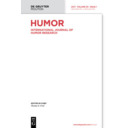Interested in joining our team? We are currently offering funded PhD positions for research topics in computational humour, historical born-digital corpora, and Indigenous language technology.
What's in a pun? assessing the relationship between phonological distance and perceived funniness of punning jokes.
Humor: International Journal of Humor Research, 38(4):643–658, 2025. ISSN 0933-1719. DOI: 10.1515/humor-2024-0060.
Punning is a form of humorous wordplay based on
semantic ambiguity between two phonologically similar words – the pun
and the target – in a context where both meanings are more or less
acceptable. While the pun is expressed explicitly, the target is invoked
implicitly in the text. Previous work has attempted to quantify and compare
phonological features of puns and their targets, looking at correlations with
the understandability of the jokes in which they occur. Our study quantifies
the phonological distance between pun and target words and assesses possible
correlations with funniness ratings of the corresponding jokes. Our
statistical analyses on a large dataset of puns reveal a significant negative
correlation between phonological distance and perceived funniness for two of
the four phonological distance measures we applied. This finding supports the
hypothesis, often (implicitly) made in previous research but never verified
at this scale, that lower phonological distance between a pun and its target
is associated with higher funniness ratings. The parameters of our study
suggest that future work should examine the semantic features of pun and
target in order to create a more holistic understanding of what contributes
to the perceived funniness of punning jokes.
@article{palmann2025whats,
author = {Anna Palmann and Tristan Miller},
title = {What's in a Pun? Assessing the Relationship Between
Phonological Distance and Perceived Funniness of Punning Jokes},
journal = {Humor: International Journal of Humor
Research},
volume = {38},
number = {4},
pages = {643--658},
year = {2025},
issn = {0933-1719},
doi = {10.1515/humor-2024-0060},
}![[A stylized clam.]](https://clam.cs.umanitoba.ca/theme/images/clamlogo.svg)



